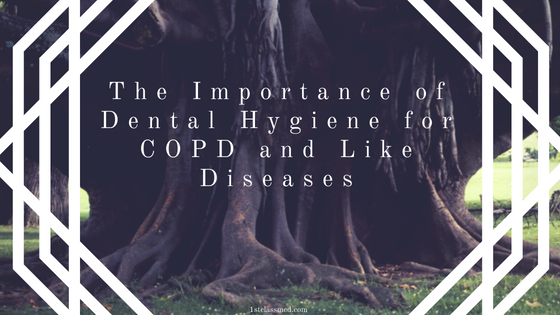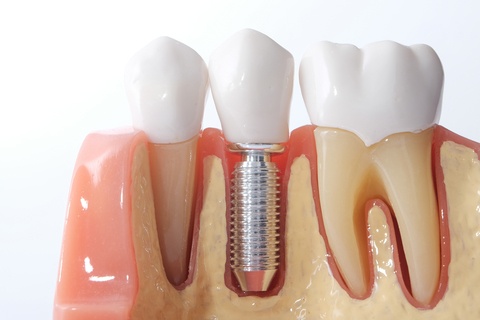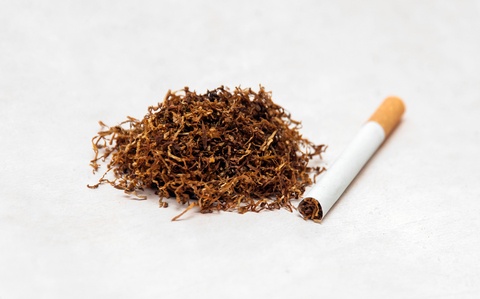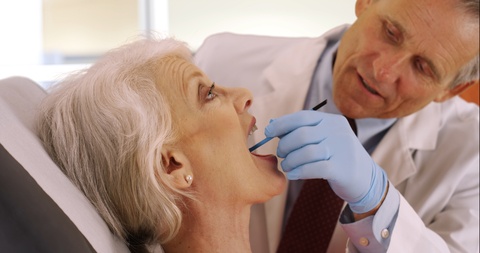
Chronic obstructive pulmonary disease (COPD) is a chronic, long-term lung disease that causes inflammation and breathlessness.
COPD is the third leading cause of death in the U.S., more than 11 million people have been diagnosed with COPD, but many have COPD without knowing it.
There are many other lung diseases that also have the feeling of breathlessness or struggling to breathe.
Some other respiratory diseases include pneumonia, asthma, lung cancer and pulmonary fibrosis.
Smoking can increase the risk of many respiratory diseases, and if continued after being diagnosed, can make the disease worse.
Dental hygiene can also be a factor in your respiratory disease, good dental hygiene can help reduce the effects of the disease on your health.
Your Teeth and COPD:

Regularly brushing your teeth and flossing can lower the amount of bacteria in your mouth, which can help your overall health.
Dental hygiene maintenance is important to prevent growth of bacteria along your gums, teeth, and tongue.
The growth of bacteria, if left for a period of time, can cause infection and inflammation in your gums and on your tongue.
It is possible that the bacteria can cause rotting teeth, as well as your teeth to fall out.
Poor dental hygiene can worsen symptoms of COPD, as the bacteria in your mouth can then cause an infection in your lungs and airways.
According to one study, less remaining teeth, high plaque scores and low tooth brushing were linked to COPD exacerbations.
This shows the importance of maintaining good dental hygiene, as it can make COPD symptoms worse.
Smoking can also increase the risk of making your symptoms worse, as it is an irritant to the lungs.
Tobacco and Your Dental Hygiene:

Tobacco is one of the top causes of preventable illnesses in the U.S., smoking is cause for roughly 20% of deaths.
Cigarettes are not the only way to intake tobacco, smokeless tobacco, cigars, water pipes and electronic cigarettes are all ways to receive tobacco.
Dental practices can help patients with tobacco cessation, as dentists can help recognize those who do smoke, and help them find cessation treatment.
Not only can tobacco and smoking affect your teeth, but your gums as well, it can increase your risk for oral cancer, tooth decay and bad breath.
Quitting smoking can help the outcome of your respiratory disease and can lower the risk of cancer and tooth decay.
Proper Dental Care:
To start off, it is important to use the right technique, but many of us do not know the right way to brush our teeth.
To use the proper brushing technique, your brush should be at a 45-degree angle to your gums and brush back and forth strokes across the sides and top of your teeth.
For the front and back of your teeth, hold the brush flat against your teeth, so the bristles are touching.
You then should move the brush up and down for the front of your teeth, as well as the backs of your teeth.
Another factor in having proper dental care is to make sure you are brushing your teeth twice a day, for a minimum of two minutes.
If you struggle to figure out how long two minutes is, play a song you enjoy that is a couple minutes, or you can set a timer for yourself.
At the end of brushing your teeth, make sure to brush your tongue as well, either with a tongue brush or your toothbrush.
When picking out a toothbrush, look for soft bristled brushes, as anything more stiff than that can irritate your gums.
Also look for a toothbrush that has an American Dental Association seal on the packaging, as that product is safe and will do a good job according to the ADA.
It is also very important to floss at least once a day.
Adding flossing into your morning or evening routine can make it a mindless tasks that can help prevent any plaque from building up.
When flossing, the floss should “hug” the tooth, creating a forward and backward C shape, using a piece of floss up to 18 inches in length, this will allow fresh floss to be used every few teeth.
This shape should allow much of the plaque and germs to get loose and clean out all the cavities between your teeth.
Mouthwash can be helpful to reach areas that brushing and floss cannot go, it can also help with the gums and prevent gingivitis.
It can be easier to use in situations where you may not be able to brush or floss, such as at work or a restaurant.
Mouthwash also comes in small travel bottles to bring with on trips or to keep handy at your desk or in your car.
What many people do not think about is the important of cleaning your brush and switching out your brush.
Though some warn to keep your toothbrush covered in the bathroom, the American Dental Association warns against covering your toothbrush.
The ADA claims that covering your toothbrush can actually grow more bacteria and introduce your mouth to new bacteria and possible infection.
Rinse your toothbrush after every use with water to clean out any bacteria, or you can rinse it in mouthwash to help kill off any bacteria.
Keeping your toothbrush in an upright position with good airflow will allow the brush to dry and prevent growth of bacteria.
It is also important to switch out your toothbrush about 3-4 times a year, or every 3-4 months.
Checking for wear and frayed bristles can help decide if you need to switch out your toothbrush.
Though it can be difficult, stop snacking after your teeth have been brushed at night is very important.
You are allowing sugar and food particles to remain on your teeth after they have been cleaned, which can help bacteria grow while you are sleeping.
Dentist Visits:

Though dentists and doctors are feared by many people, regularly seeing them is good for your health and your respiratory disease.
Dentists should be seen about twice a year, roughly every 6 months.
Dentists and doctors are able to check in on your progress of your respiratory disease and your oral health to determine if it is progressing or maintaining the same level of severity.
Dentists will also remove any tartar buildup, look at possible cavities and make sure your teeth and gums are healthy.
They can check to see if there is any infection or inflammation and then determine if any additional steps need to be taken in your dental routine, or if any adjustments need to be made in your current routine.
Those who brush their teeth often and visit the dentist as recommended are less likely to experience exacerbations or flare-ups.
Conclusion:
It is important that dental hygiene is maintained for those with respiratory diseases, as it can help keep infection and bacteria at bay.
Quitting smoking can help as well, and it can cut down on the risk of oral cancer, and tooth decay.
Meeting with your doctor yearly and dentist every 6 months can help keep and eye on your respiratory disease, as well as any dental issues.
Your dentist will be able to clean you teeth and discuss more with you about any issues they may find and how to treat it.



